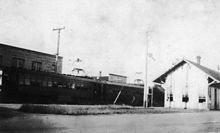Portland, Eugene and Eastern Railway

A Red Electric train at Southern Pacific Depot in Beaverton
|
|
| Overview | |
|---|---|
| Service type | Interurban passenger |
| Locale | Oregon |
| First service | January 17, 1914 |
| Last service | October 5, 1929 |
| Former operator(s) | Southern Pacific Company; operated as Portland, Eugene and Eastern Railway 1914–15 only |
| Technical | |
| Track gauge | 1,435 mm (4 ft 8 1⁄2 in) |
| Electrification | 1,500 V DC, overhead |
| Track owner(s) | Southern Pacific Company |
The Red Electric was an interurban passenger train service operated by the Southern Pacific Railroad in the Willamette Valley of the U.S. state of Oregon from 1914 to 1929. The service got its name from the bright red color of its cars. Despite its short history, among West Coast interurbans it was unique, and it was considered the finest such system in the Pacific Northwest. It was the only major electric interurban railroad converted from steam to electric passenger use. It was also one of few systems using all-steel equipment, and one of the largest 1500-volt systems in the country.
The Oregon Electric Railway completed an interurban line from Portland to Eugene in 1912, as well as several branch lines to agricultural, business, and population centers in the Willamette Valley. The Southern Pacific (SP), feeling threatened by this competition, researched the feasibility of electrifying most of its Willamette Valley trackage. At the time, electric traction was seen as the way of the future, and in 1912, SP began converting existing steam routes to overhead electrification. Via the Red Electric system, which SP established on rail lines it acquired from the Portland, Eugene and Eastern Railway (PE&E), the company planned to electrify all of its Oregon trackage except for its main line through the valley from Portland to California. The projected growth of the rural areas outside the main population centers of Portland, Salem, Corvallis, Albany and Eugene, however, did not materialize, despite the efforts of real estate promoters. The combination of this lack of growth, World War I and the rise of the automobile meant that the Red Electric system was far smaller than originally intended. The final Red Electric run took place on October 5, 1929.
...
Wikipedia
